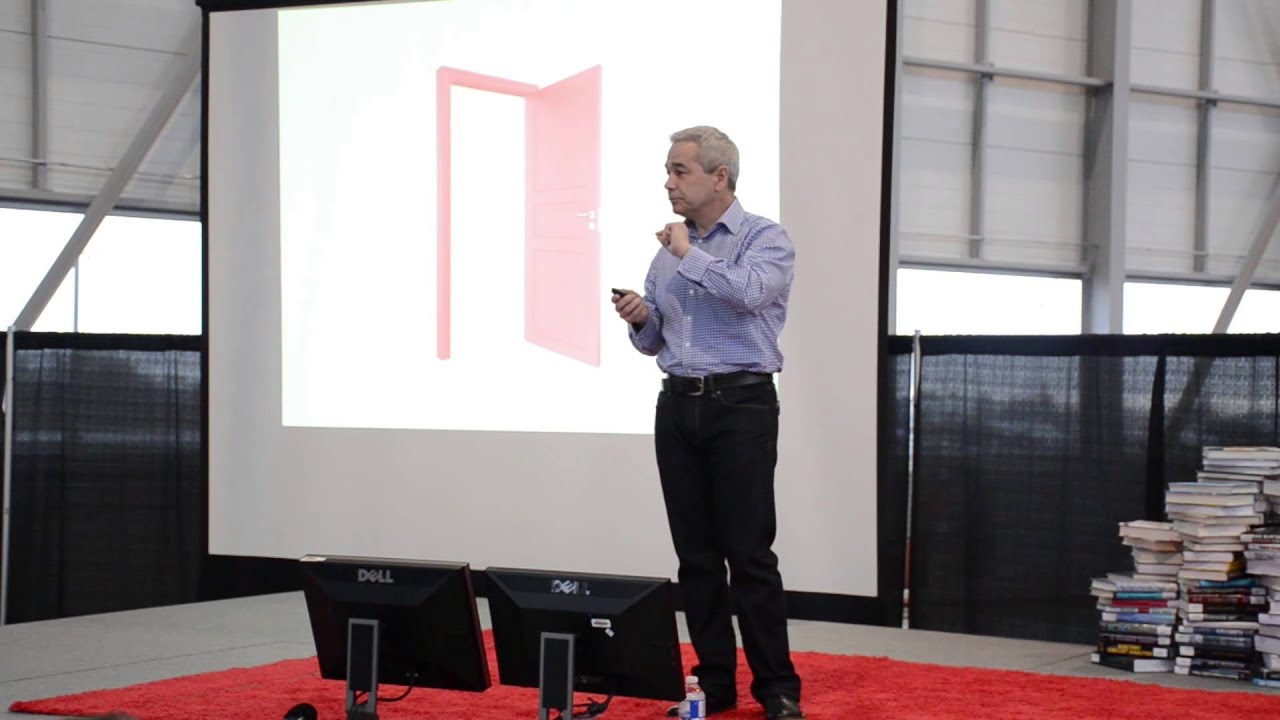Returning to Work: 8 Key Strategies for Businesses to Prepare for and Support Employees
The COVID-19 crisis has confronted leaders, managers and businesses with one of the biggest challenges ever encountered in protecting the physical and mental health of employees along with a severe impact on business operation and productivity.
Many people and businesses have learnt to adapt to discovering and implementing new, effective and creative ways of keeping things going.
Adapting to WFH has brought both difficult demands, as well as huge opportunities for different ways of working and doing business.
Through this crisis we have not only witnessed the adverse impact on our physical, social, financial and professional status and wellbeing, we have also seen how hugely detrimental this has been to people’s mental health.
Millions of us have had to make major adjustments to personal loss, isolation, restriction of movement/travel, social distancing, job insecurity and unemployment, as well as combining work with home life. All of which have contributed to high levels of stress, fear, anxiety and uncertainty, along with increased mental health problems.
Learn more: Getting us through the crisis: 10 ways to build mental resilience
Returning to Work – the Next Big Challenge
With the recent decision of a gradual return to work, employees and businesses are faced with a major new challenge.
How can they prepare for and support a safe and effective return to work?
Sustainable strategies, to address this issue, require recognition of a number of factors.
Understanding and responding adequately to stakeholder expectations, safety requirements for physical and mental health, as well as addressing the psychological impact of this crisis are crucial in supporting employees to re-enter and to confidentially engage in their work.
A significant starting point is the acceptance that a return to work, for many people, will not be business as usual and that working practices will need to change.
It is also important to be aware that individuals react very differently to challenging events, so it can be useful for leaders and managers to be prepared for a range of different responses.

How to Prepare for and Support Employees Returning to Work: 8 Key Strategies
1. Acknowledge Employee Needs & the Impact of the Crisis
Leaders and Managers can greatly benefit from an awareness and understanding of the psychological and emotional consequences of the present crisis. A clear acknowledgement of the situation, its impact and the continuing risks express both the recognised responsibility and enlist joint cooperation.
2. Check-In & Offer Emotional Support
Leaders and managers should also take time to check in on employees and find out how they are doing.
Empathy is an important part of how to express a genuine understanding and interest in the experience and welfare of others.
Listening and acknowledging how the situation could be impacting people and offering appropriate support services, helps decrease fear and promotes a sense of security.
3. Ensure You Have Open & Continuous Communication
One of the most helpful and essential processes, particularly, when dealing with crisis situations, is providing employees with relevant information on their work, as well as the business status, ensuring to keep people regularly updated.
In seeking to reassure and reduce anxiety and uncertainty, employers can support by providing a clear explanation of work changes and expectations, along with details on how the situation is being managed.
In responding to the Covid-19 crisis, it is particularly important to clearly communicate the health and safety measures, which have been put in place to protect the welfare of all employees.
People need to have confidence that someone is taking responsibility and that action is being taken to address the situation in the best way possible.
4. Understand Expectations & Remain Flexible
Whatever the expectation there is a need to listen, acknowledge and wherever possible try to accommodate reasonable expectations.
Respectfully expressing what clearly can be done rather than what cannot be done for unmeetable expectations.
Being flexible and making reasonable work adjustment is vital to being supportive, as well as gaining optimal engagement and productivity.
Businesses should consider the possibility of flexible conditions related to work hours, working from home, employee roles and tasks, time off, an adaptation of working practices and provision of any necessary resources.
5. Review & Establish Your Business Processes
Businesses should ensure that comprehensive and up-to-date policies and procedures are established, which specify clearly defined regulations and resolution strategies.
Enabling businesses to perform at optimal level involves having people and operating systems, which possess adaptable and flexible reactions with a problem-solving approach. Employees are then fully informed and can function within an effective structure with clear guidance.
6. Match Present Demands & Needs with Appropriate Responses
Businesses and employees greatly benefit from being supported and cared for through the guidance and resources they are given.
Following any crisis, businesses should be committed to getting things back on track, as safely and quickly as possible.
Identifying the present demands and needs of employees and responding in a direct and practical manner actively supports this process. This also contributes to building a strong and positive company culture, in which employees are more able to trust and feel safer.
7. Navigate a New Course
If businesses are to maintain direction and respond successfully to the needs of employees and the demands of the situation, then openness to different ways of doing things is an absolute necessity.
Progress can be held back by insisting on sticking to a particular course and not adapting to working practices.
Recognising when something is no longer necessary or fit for purpose and altering direction, serves to constructively optimise an employees’ return to work.
Leaders and managers can develop and implement changes through lessons learnt, good practice, continuous feedback and clear complaints and corrective measures process.
8. Connect & Utilise External Professional Services
Following a crisis, people can often feel fearful or apprehensive about returning to work.
Businesses can then benefit from investing in support services, as well as collaborating and building new partnerships.
Working together with relevant professionals and organisations can aid innovation, a greater sense of safety, better engagement, increased productivity, as well as the creation of strong and effective support structures. Most importantly this can promote the positive health and wellbeing of leadership and employees.
Join the Conversation
We’d love to hear what you have to say.
Get in touch with us on our LinkedIn Group, Facebook Group or Twitter.
Successful businesses of today and emerging consumer behaviour trends
Money makes the world go round.
Today the world spins slower for some businesses, it takes a break or even ends, unfortunately.
But other businesses are flourishing now as there is always an opportunity in every crisis.
It is not the strongest of the species that survives, nor the most intelligent that survives. It is the one that is most adaptable to change.
Charles Darwin
The same goes without saying for the business jungle in capitalism.
It seems that the most successful companies are either present at the right moment, are creatively adjusting to the circumstances bringing along innovations or they are rich enough to weather the storm.
Here is a shortlist of the industries in the US and worldwide that have risen lately or remained successful today. They are listed in a more or less order of importance and are followed by a few new trends in consumer behaviour in the business environment in Romania.
Winning industries
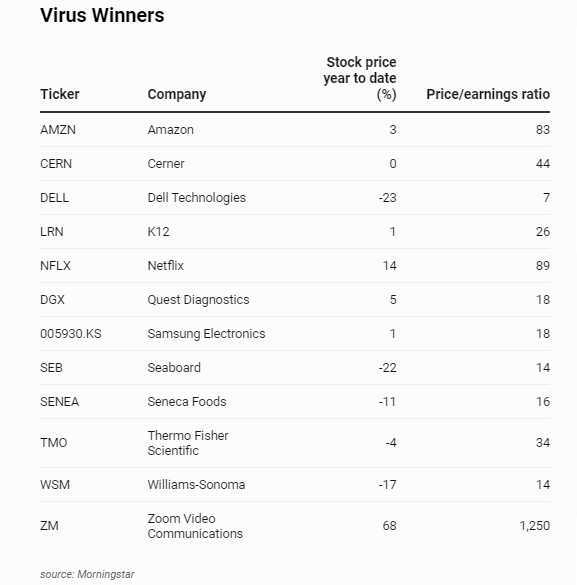
Image source: Forbes
To begin with, this is a radiography of the most important players at the beginning of March 2020.
Experiencing the work-from-home economy
HOME, a word that has been used too often lately, generally associated with the construction/furniture/design industries and the family concept is now correlated with business, jobs and as well with spending the spare time during coronavirus lockdown.
It seems every generation lived through a crisis, and we are not spared either. The difference is that the causes are more subtle nowadays, as the effects are always serious. What began as a trend not long time ago, especially in the IT business – the work from home system, has now quickly spread all over the world and created the so-called work-from-home economy.
Teleconferencing
The most used teleconferencing system, Zoom is now a synonym for remote work. No wonder its stock exchange exploded in 2020.
Founded in 2011 by the Chinese Eric Yuan, it took Zoom only 8 years to reach 2,532 employees, $622 million revenue and $21 million net income in 2019.
Before coming to Silicon Valley and working for Cisco Webex as an engineer, Zoom founder Eric Yuan was denied a visa by the US government 10 times.
The second most known winner in the same industry is Webex – Cisco Systems.
Besides teleconferencing, cloud computing, software and cybersecurity companies have also been increasing.

Home entertainment
Netflix, the films and television programs streaming service is no doubt the solution of choice in home entertainment.
The company was founded in 1997, in California and came to Romania only in 2016. With 169 million users worldwide, it reached in 2019 an amazing revenue of $20.156 billion and a net income of $1.866 billion.
After Netflix, it seems that more people are turning towards video games, as the young and the adults as well play a lot these days.
Healthcare
We are talking here about a huge system, ranging from medicines, protection materials to virus tests and the vaccine industry.
Thermo Fisher Scientific, for instance, is a player in the medical testing equipment industry. Today the medical dictionary is adding new words as we are already talking about AI-based platforms that use voice to detect & monitor the health status, or telemedicine services – virtual medical services.
We are also seeing an increase in competitor collaboration, as GSK and Sanofi, two of the world’s biggest pharmaceutical companies, are joining forces to create a COVID-19 vaccine.
Online education
As schools close, K12 is the winner in the US, a company which delivers software-based educational services.
A global trend lately, the education has moved online in an accelerated rhythm, universities worldwide have more and more online training options and there is an abundance of webinars, online classes and trainings.
A great variety of online classes makes it now easier than ever to learn whatever you wish: there are platforms that bring huge education resources under the same umbrella such as Udemy or platforms concepts that reunite world top experts such as Mindvalley, Gaia or Masterclass.
One might find it a little bit overwhelming, as there is an avalanche of information and technology that our brain begins to cope harder with. The situation is also creating the feeling of not having enough time to process or to integrate the information.
Telecom companies
As we are staying home, the need to talk to our family and friends and as well as with the work team is more powerful. That ensures the stability of the telecom industry at this moment.
Consumer goods
Even if they do not really need to, people are buying more lately. Amazon and Alibaba online marketplaces rule worldwide.
The Los Angeles Times has announced that Amazon.com stock climbed 5% last week, increasing Jeff Bezos’ empire with $ 24 billion in the first three months of this year.
In the US, Williams-Sonoma, a retailer of food home preparation gear, Seaboard Corp., a seller of food commodities and Seneca Foods Corp., a producer of frozen and canned foods are the market segment leaders.
Walmart’s sales have also increased by 5% since the beginning of the year.
Johnson & Johnson, specialized in pharmaceutical and consumer goods and its competitor Procter & Gamble are also recording higher sales.
Electronics & IT products
In the US, Dell Technologies is in top sales in its segment as employers are upgrading the laptops their employees use to work from home and Samsung Electronics continues to sell phones and TVs.
Banking – contactless payments
Be it online, by card or by mobile, the digital payments technologies are experiencing a new boom at this moment. As a result, tracking payments and gathering data on customer preferences will be more precise.
A few trends in the Romanian business environment and consumer behaviour
At a certain moment, hopefully soon, life will go back to normal. But it will be a whole different normal as things will never be the same again.
Living and doing business in Romania have already changed, hence consumer habits have changed, too.
People are reconsidering their lifestyle, the way they perceive the world and their personal values.
They are enjoying family experiences, they spend more time with partners and kids. They communicate more with friends. Online school has become the norm.
In the last years, the classic television consumption has decreased step by step. But if we are to compare March 2019 and March 2020 figures, the following result emerges: there are 360.000 more viewers at the national level and the total audience watching TV in the evening (prime-time) in March reached 8,6 million out of a total population of 22,175 million (Romania’s population at January 1st 2020). Of the 360.000 persons, 250.000 are urban viewers.
The video streaming platforms Netflix and HBO Go have also reached high usage levels. No data available for Romania for 2020 regarding the percentage increase, yet at the end of 2019, a study on urban media consumption habits showed that 7 Romanians out of 10 have at least one video streaming subscription.
Less is more. People think twice now before spending their money. They hope for the best while preparing for the worst.

Romanians are cooking and baking more at home. The internet buzzes with homemade food and deserts pictures. We are suddenly realizing that we can cook healthier and cheaper at home. In the weeks before Easter, a shortage of yeast occurred; it was so unusual to see the message “updated yeast stock” on a grocery website.
When talking about learning habits, we are experiencing a technology learning boost as people are using a greater number of applications and in a more intense rhythm than before. Many older people are also trying to make up for the gap between them and the young when using modern technologies.
It is very likely that some of the temporary changes and adaptations that we are undergoing now will become permanent. For sure companies will be more open from now on to videoconferencing services and to remote work systems as going to the office means spending time and money.
More offline businesses are moving online and they do it in an accelerating way, forced by the situation.
A lot of selling platforms appear as a business opportunity to facilitate and capitalize on the new wave of offline-online transition. At a larger scale, I’ll mention the Elefant Marketplace initiative, a place companies can sell online and also benefit from the existing logistics services. Emag remains the leader marketplace in Romania with 16.350 active sellers and group revenue of RON 4,77 billion (in 2018).

At a smaller scale, we are witnessing the appearance of many online platforms and the usage of social media as selling channels for local, independent small businesses. First, there were greenery and vegetables supplying services, now farming products such as meat, cheese or milk are going online. Besides, the online groceries number has increased in a very short period of time.
I am glad to see there is now an increasing preference for local and made-in-Romania products and that the business-to-consumer chain is becoming shorter. Business people and big retailer chains are becoming aware that stocks are also easier to update when collaborating with local suppliers.
Previously niche industries are becoming a normal standard – food and goods delivery companies such as Glovo, Foodpanda, UberEats, Bringo and Takeaway are gaining more popularity.
People and businesses are reinventing themselves right now, they respond quickly to the situation challenges. They are either innovating the existing offer of products and services, either reinventing 180 degrees the businesses models.
For instance, transportation companies such as Bolt and Free Now (ex Clever) are launching Business Delivery services to connect the suppliers with the end consumers and increasing their brand awareness by offering free rides for medical personnel. they are also going to fit their cars with protection screens set between the driver and the clients.
Everybody is selling or producing face masks – starting with clothes manufacturers to the neighbourhood-tailoring little companies.
They say the Romanians are inventive and witnessing many total business shifts proves that right. Now it is not important what you sell, but to sell nonetheless: from watches to FMCG, from toys to face masks and medical protection equipment, from events organizing to delivering weekly cooked food subscriptions. A Romanian bus manufacturer switched to disinfection tunnels. A state-owned arms manufacturing company has adapted its production and will begin to make protective masks.
New ways of advertising emerge now. I don’t think I’ve seen so many free trial products/services before or so many free resources for short term access. The video content continues to rise.
The electronic signature is beginning to be accepted in official documents with public authorities and institutions.
Accessing start-up funds and European funds are still available instruments in the actual business environment.
At the end of March, the total internet traffic in Romania increased by 12% in mobile networks and 20.9% in landline networks, while voice traffic recorded average increases of 22% in mobile networks and 22.7% in landline networks (source).
It seems that now we talk more on the phone at noon than in the evening, and in some networks, voice and data traffic no longer have high values in the morning and evening, but have become linear throughout the day.

Instead of conclusion
Here are two questions that don’t want to leave my mind these days:
Can’t stop wondering, yet in the end what are the real companies – the economic giants and who are the persons/powers that will benefit the most from people’s health problems and the economic crisis? These are open questions for anyone who wants to put the puzzle pieces together. I cannot stop thinking either how fragile our life is.
And what about the consequences of the social distancing/working-from-home trend on an anthropological level? I know, superficially said, as first reactions, maybe more divorces and maybe more children at the end of the state of emergency. But I mean at a deeper level, regarding future human behaviour.
Mark Mason, BRAND MINDS 2020 speaker (the event was rescheduled for September 25th) has recently launched the FOGO concept (the fear of going out), starting from FOMO – the fear of missing out.
FOGO is the inversion of FOMO. Whereas someone with FOMO feels constant anxiety that they may be missing out on something spectacular by staying in, people with FOGO live with constant anxiety that they are guaranteed to miss out on something horrifying by staying in.
Mark Mason
Joe Dispenza and other scientists say you need 21- 30 days to install a habit, to rewrite a neuronal path and a few months of practice to make it last.
It seems that we are going to experience the “stay-at-home” state long enough to create and enhance new habits. Another open question…. Time will show us quite soon.
Stay safe. Be well.
Join the Conversation
We’d love to hear what you have to say.
Get in touch with us on our LinkedIn Group, Facebook Group or Twitter.
Co-Working Spaces and Their Role In Boosting Creativity For Small Businesses
As shown at the Global Coworking Unconference Conference forecast, by 2022 there will be 30,432 spaces and 5.1 million paid co-working members worldwide. The market shows an average annual growth rate of 24.2 percent since 2007, and is less a way of working now than a way of life. At the same time, the self-employed knowledge worker sector is growing too, bringing with it the need for hubs to provide social interaction, alternative locations than the cramped office desk or coffee shop, and clusters of interaction for connectivity.
It’s really easy to see that for startups and small businesses, the co-working solution ticks all the boxes of flexible, affordable space, and a creative hub to foster new ideas and new business.
According to Deskmag’s annual Global Coworking Survey, 71 percent of participants reported a boost in creativity since joining a co-working space, while 62 percent said their standard of work had improved. The study also found that half of all co-workers access their work space around the clock–with only 30 percent preferring to work during normal business hours. “The future of work should not be dictated by space or place, but by the individual and the tasks that he or she has to deliver,” Regus CEO Mark Dixon told Fast Company.
Moreover, an overwhelming majority (90 percent) of co-workers said they got a self-confidence boost, likely due to the fact that many spaces are filled with supportive communities that enable creative collaboration.
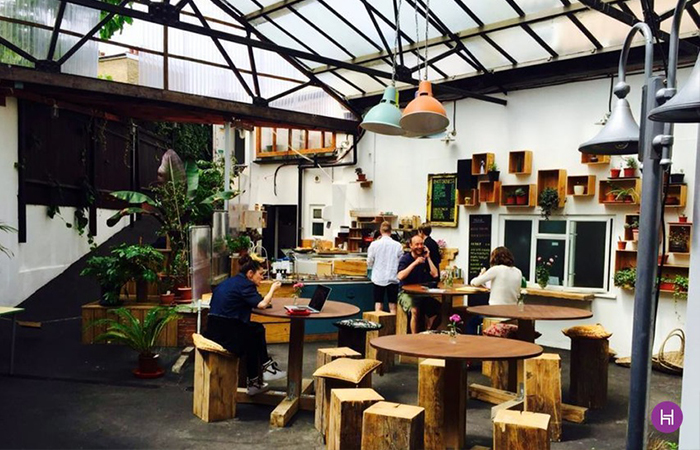
There is no doubt that co-working office spaces are the future of the business world. Having the option to consult with and share ideas with other like minded business owners and freelancers gives you the chance to bring different ideas and opinions into how you do your work and could expand your business more than you ever dreamed. At the same time, networking is made possible like never before. There is no better way to expand your inner circle than to be working closely with hardworking, determined individuals who all desire a common goal. Collaborations with future employees may take your business to a level you never thought possible.
The co-working model also generates a creative economy made up of individuals who not only need an inexpensive way to operate, but need a consistent flow of new people, new ideas, and new opportunities. Without this type of engagement, creatives are forced to seek employment elsewhere, such as with a corporation, and this limits their ability to engage with other local businesses that could benefit from top-tier talent on a small-business scale. But being together in the same place can translate in beautiful-shared ideas and new concepts coming to life. And,why not, new business opportunities.
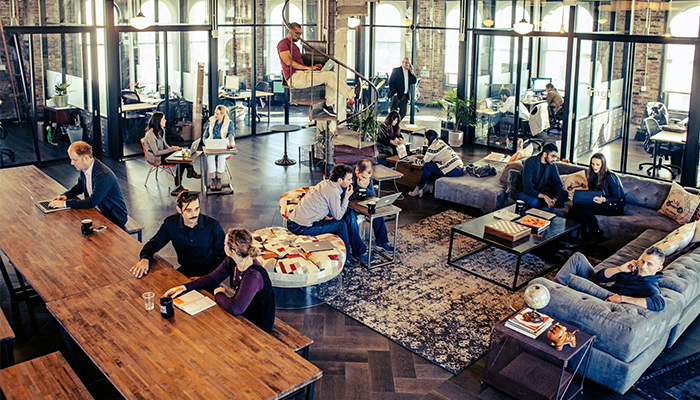
Local business like restaurants,coffee shops, galleries, can also benefit from co-working spaces through direct programming, partnerships, and access to pools of available, independent contractors in industries like interior design or legal services.
Working amidst people doing different kinds of work can also make one’s own work identity stronger. Our respondents were given the opportunity to frequently describe what they do, which can make what they do seem more interesting and distinctive. (….) the variety of workers in the space means that co-workers have unique skill sets that they can provide to other community members.- hbr.org.
What will the new Facebook news feed changes bring
One of Facebook’s big focus areas for 2018 is making sure the time everybody spends on Facebook is time well spent. “We built Facebook to help people stay connected and bring us closer together with the people that matter to us. That’s why we’ve always put friends and family at the core of the experience. Research shows that strengthening our relationships improves our well-being and happiness. But recently we’ve gotten feedback from our community that public content — posts from businesses, brands and media — is crowding out the personal moments that lead us to connect more with each other,” wrote Facebook’s creator Mark Zuckerberg.
Moreover, according to him, the social media platform’s representatives feel a responsibility to make sure their services aren’t just fun to use, but also good for people’s well-being.
Therefore, the company invested in a deep research that shows that when we use social media to connect with people we care about, it can be good for our well-being. We can feel more connected and less lonely, and that correlates with long term measures of happiness and health. On the other hand, passively reading articles or watching videos — even if they’re entertaining or informative — may not be as good.
Based on the research and the new desires for the brand, some of the main changes will be seen by Facebook’s users in the nearest future. Facebook’s News Feed algorithm will prioritize “meaningful social interactions” over “relevant content”. Moreover, Facebook will de-prioritize videos, photos, and posts shared by businesses and media outlets, which Zuckerberg considered “public content”, in favor of content produced by a user’s friends and family.
“The shift is the most significant overhaul in years to Facebook’s News Feed, the cascading screen of content that people see when they log into the social network. Over the next few weeks, users will begin seeing fewer viral videos and news articles shared by media companies. Instead, Facebook will highlight posts that friends have interacted with — for example, a photo of your dog or a status update that many of them have commented on or liked,” wrote The New York Times.
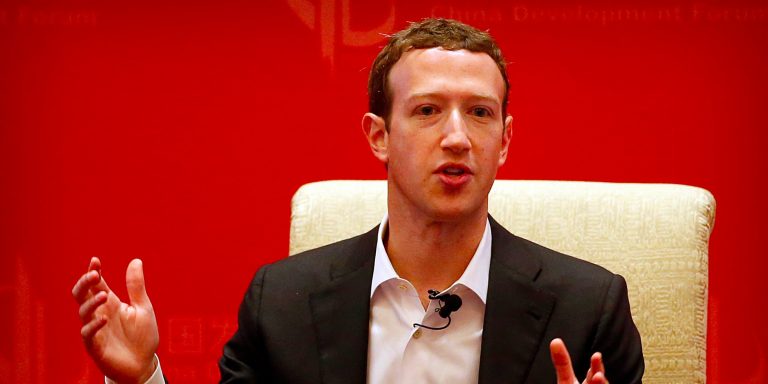
“The changes seemed designed to quiet some of the maelstrom of criticism Facebook has received in the past year, as critics have taken the company to task for cloistering users in filter bubbles, facilitating the proliferation of misinformation, allowing foreign interference in national elections, and exploiting human psychology for profit,” wrote Julia Carrie Wong for The Guardian.
But, the biggest problems that may arise, apart from unimportant, silly posts being “privileged”, the changes in Facebook’s News Feed will affect the most the publishers, nonprofits, small business and many other groups rely on the social network to reach people. Adam Mosseri, vice president of product management at Facebook, who is responsible for running the News Feed, quoted by New York Times, acknowledged that “there will be anxiety” from partners and publishers who often complain about the constant changes in what will be shown across the network.
Moreover, according to ABC, “the latest move represents a major shift, one intended to highlight the posts users are most likely to engage with rather than passively consume. There will be fewer videos, which Facebook considers “passive”. The changes won’t affect ads and will likely hurt businesses that want to reach followers without paying to advertise”.
It’s interesting to see how will the other social networks react to this Facebook change and how much it will actually impact the brands and businesses.
Batteries, solar panels and the end of fossil fuels
A study published in January in the Journal of Sustainable Finance & Investment predicts that the combination of battery storage with renewable energy will make fossil fuels increasingly obsolete. The driving forces of this disruption include the “decline in retail renewable electricity prices,” along with plummeting costs of batteries. Fossil fuels are the most widely used source of energy because of base load power, which means they provide energy at all times, night and day. In contrast, renewables have faced the ‘intermittency’ challenge—the sun doesn’t always shine, and the wind doesn’t always blow.
But authors Jemma Green and Peter Newman of Curtin University in Australia show that as storage gets cheaper, renewables will become more competitive with fossil fuels on costs and reliability. By 2050, these irresistible technological and market forces could make oil, gas and coal seem too costly and cumbersome, leading renewables to account for “100 percent of global energy demand.”
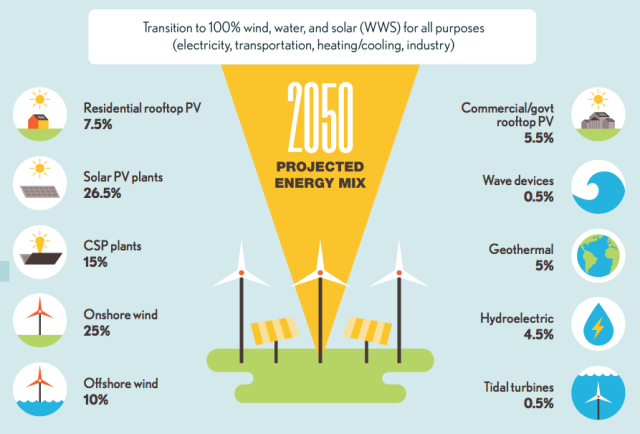
source: energyathaas.com
According to Vicente Lopez-Ibor Mayor, chairman of Lightsource—the biggest solar energy company in Europe—there will be an immediate impact within just three years. Moreover, Mayor told Motherboard that the speed of technological improvement means solar storage is “going to be massively disruptive to the business-as-usual processes of oil, gas and coal.”
In three years, he said, it will “begin to transform” the electricity infrastructure of major cities. “Solar storage is pitched to become so cheap it will make relying on natural gas peaker plants pointless…It will lead to rapid adoption of solar by businesses, local governments, and households—not because people are environmentally conscious, but simply because it will make more economic sense.”
More on their approach you can read here.
The Powerwall system
While wind and solar power have made great strides in recent years, with renewables now accounting for 22% of electric energy generated, the issue that has held them back has been their transience. But now, the renewable power billionaire Elon Musk has just blown away that final defence. In an event held in California he introduced to the world his sleek new Powerwall – a wall-mounted energy storage unit that can hold 10 kilowatt hours of electric energy, and deliver it at an average of 2 kilowatts, all for US 3,500. That represents an electricity price (taking into account installation costs and inverters) of around US 500 per kWh – less than half current costs, as estimated by Deutsche Bank.
“That translates into delivered energy at around 6 cents per kWh for the householder, meaning that a domestic system plus storage would still come out ahead of coal-fired power delivered through the conventional grid,” explains iflscience.com.
Moreover, the reality is much closer than we might think as Musk is going to manufacture the batteries in the United States, at the “gigafactory” he is building just over the border from California in Nevada. And that while not staying and waiting for some totally new technology, but scaling up the tried and tested lithium-ion battery that he is already using for his electric vehicles.
The Powerwall system offering 10 kWh is targeted at domestic users. It is complemented by a commercial system termed the Powerpack offering 100 kWh storage, and a stack of 100 such units to form a 10 megawatt hour storage unit that can be used at the scale of small electricity grids. Whole communities could build micro-grid power supply systems around such a 10 MWh energy storage system, fed by renewable energy generation (wind power or rooftop solar power), at costs that just became super-competitive.
More than that, Musk declared that the entire electric power grid of the US could be replicated with just 160 million of these utility-scale energy storage units. And two billion of the utility-scale units could provide storage of 20 trillion kWh – electric power for the world.
Solar panels have repaid their fossil fuel debt
At the same time, another study says that thanks to the growing solar power capacity around the world, solar power has reached the break even point. The study from the Netherlands, published in Nature Communications, says that the power generated by solar photovoltaic panels over the last 40 years has offset the polluting energy used to produce them.
By the researchers’ calculations, for every doubling of global solar power capacity, the energy used to produce them fell by 12-13 percent and greenhouse gas emissions fell by 17-24 percent, depending on what material was used. Solar capacity has grown roughly 45 percent a year since 1975, reaching 230 gigawatts (GW) in 2015. By the end of 2016, there could be 300 GW installed.
“The researchers believe the break even point was likely hit about five years ago for both energy consumed and emissions meaning, at this point, global solar energy is having a net positive impact and will continue to increase that positive impact going forward. This feels like a major cause for celebration. If you’re a homeowner with solar panels, the researchers say that individual solar panels repay their fossil fuel debt several times over during their average 30-year lifespan,” wrote Megan Treacy for treehugger.com.
7 Things you might not know about Robert Murray
Based out of the Vancouver Lower Mainland, Robert Murray is a #1 Best Selling Author, Global Speaker and Business Strategist. He has written three critically acclaimed books on leadership: “It’s Already Inside,” “Unlocked,” “Simple Leadership – Simply Said.” that are a collection of short stories that help his readers relate to and nurture the leader within themselves.
- He believes in people and their limitless potential. He wrote Unlocked to help leaders unlock their remarkable greatness through using their ‘whole brain’ – both the logical brain as well as the emotional mind to become a more complete leader – the leader he calls a ‘Practical Leader’.
2. He is able to see simple, executable and engaging solutions where others see only problems. Has worked with senior executives of multi-billion dollar ventures to improve their future, further engage their community stakeholders, and essentially fix their problems. Bob is experienced in virtually all areas of the corporate development, and he is passionate and energized about helping companies be the best they can be.
3. Bob is a storyteller. He is a visionary, he is dynamic and he is engaging. He shares his energy, enthusiasm and knowledge in hopes of helping people discover their limitless potential. He tells stories which help people find the keys to unlock the innate leader that lies within.
4. Coming from a farming family in the heart of Canada, and working my twenties as an industrial electrician, he learned life skills that are hard to find in a classroom. Expertise such as: problem solving, emotional intelligence, and how to selflessly serve others.
5. Getting his marketing degree at University at night, while working through junior level marketing roles during the day, he learned discipline, drive and to always chase his passion.
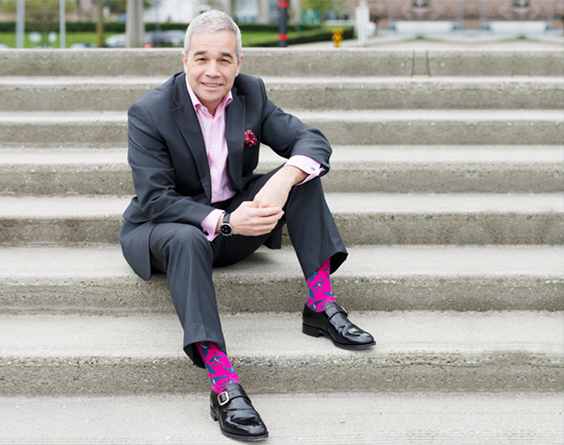
6. The single biggest mistake he sees virtually everyday in businesses on every corner of the globe are leaders that don’t take culture seriously and think that the way to success is complex strategies that no one understands. Robert believes that successful businesses have values aligned cultures and simple strategies.
7. He has built strategy for over 200 organizations from Fortune 50 to small 10 person businesses.
Why it’s worth working with freelancers

After the economic crisis the whole system changed and it will never get back to what we used to know. That is a given fact, proven times and times again. Adapting to this new reality, that came with its pros and cons, business owners had to change the way they were thinking prior and enjoy the new possibilities it offers. For instance, really experienced people that decided to go on their own and try being freelancers or digital nomads or small entrepreneurs.
What does a business owner or a manager win by collaborating with freelancers instead of full-time job employees? We gathered some major points one should definitely take in consideration
Experience and affordability, working hand in-hand
While hiring a full-time employee comes with a lot of responsibilities and financial and legal hustle, outsourcing part of your services to freelancers offers the company the possibility to pay a smaller fee compared to one offered to a company or a full-time employee, for a more experienced, professional personal. A freelancer working remotely doesn’t have to meet lots of overhead costs. Additionally, freelancers generally cover their own health care and other such benefits.
Moreover, they worked on a variety of different businesses from diverse locations, which makes them really valuable in insights and know-how. Each client or job adds more experience to their craft, bringing more skills to their ever growing arsenal.
Flexibility
Flexibility in projects and in hours. As most of the freelancers choose this type of professional life due to the flexibility it offers them in arranging their time as they consider fit, choosing the projects they take on, it also offers them the flexibility in their approach to you, the business owner or company representative. The freelancer will be able to work, without complaining, at hours that the employees wouldn’t consider fit. At the same time, don’t forget that you can always choose to work with a freelancer that lives miles and continents away, therefore the flexibility running higher. Frankly, the main reason why many freelancers have opted to freelance is because they love setting their own working hours.

Freedom
Derived from the previous point, choosing a freelancers also comes with more freedom, both for you and the freelancer. Instead of engaging a full-time member of staff, you can conveniently work with an external resource person on a need basis. Engaging a specialized freelancer only project based or on a limit period of time will prove to be cost-effective and very lucrative.
Fast and great quality
For a freelancer the reputation is one of the main assets he / she possesses, therefore they will always be motivated and show a lot of initiative and interest in the project, doing a fast and great work, every time. They fully understand that it’s in their best interest when they remain reliable and exceed your expectations.
Adapting better to new trends and technology
As a freelancer one must always be up to date with the latest technology and not be surprised by almost anything in their field. Moreover, being an expert also brings the need to always learn, get more expertize and better oneself. Qualities that the employer will receive every time they contract a freelancer, without having to invest in employees’ specialization, workshops or other types of training.

Good experts in specific tasks
When looking for a particular skill or having a special need, a professional freelancer specialized on a certain field is the perfect answer to one’s problem. Your project only has to gain from this collaboration.
Their understanding of small and medium businesses
Freelancers understand better the way the small and medium businesses function and are able to offer them the right solutions to their problems and help them grow. Because they often work on start-up projects they pick up a lot about how to build start-ups properly and how things ought to be done. Agencies tend to work with bigger clients or established SMEs whereas the freelancer is more of a natural fit. After all becoming a freelancer is like starting your own business in many ways.

Inspiration at its best
Working remotely, from the middle of the forest, in top of a mountain or on the beach, wearing want makes him comfortable and not an “work outfit” makes the freelancer be a more inspired and creative person. And that will only benefit the work you are doing together.
Happy client, happy freelancer
Each time a project is finalized successfully and the client is happy, so is the freelancer that knows a good review will help him along in his career more than if he would have been just an employee.




